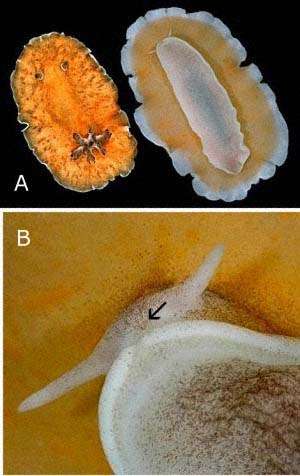
The nudibranch head
PHOTO
A,B. Dorsal and ventral views of Platydoris sanguinea (Dorididae). B, closeup of underside showing head, mouth (arrowed) and oral tentacles. C. Dorsal view of front of Chromodoris hunteri (Chromodorididae) showing pair of white lamellate rhinophores and left eye (arrowed), partially visible through the skin. D. Front of Hypselodoris infucata (Chromodorididae) showing oral tentacles (left one arrowed) partially hidden by the mantle skirt. PHOTOS: Bill Rudman.
In most animals the 'head' is easy to find. It is at the front of the body, has a mouth and sense organs like eyes, ears, nose or antennae. The 'head' in a dorid nudibranch is a bit more confusing because usually all that you can see as the slug is crawling along are a pair of prominent rhinophores, which 'smell' chemicals in the water. The eyes are very small and usually invisble, but can sometimes be seen as little black specks hidden deep beneath the skin, behind the rhinophores. The mouth can only be seen if you turn the slug over, because it is hidden beneath the mantle skirt. I have described the function of the rhinophores on a separate page. Here is a little about the other parts of the 'head'.
EYES: the sea slug eyes sit deep inside the body on top of the brain. These small black spheres cannot see images but are able to distinguish light and dark. They may warn the slug of predators by detecting shadows, and they are probably useful in helping the slug's internal body clock stay timed to day and night. (see photo C)
ORAL TENTACLES: In dorids these are usually tapering cylindrical feelers on either side of the mouth. They are primarily concerned with touch, helping the slug feel its way but they probably also can sense chemicals. (See photos B,D)
MOUTH: The mouth usually opens at the end of a short 'snout' with an oral tentacle on each side. It is quite unlike our mouth, being just an opening to allow the slug's feeding apparatus (and associated radular teeth), to come out and bite, rasp or suck in its food. (see photo B)
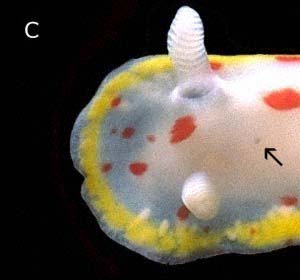
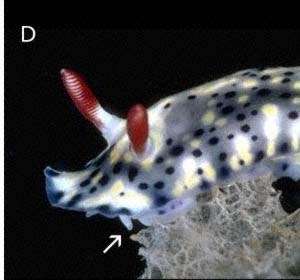
Rudman, W.B., 1999 (March 26) The nudibranch head. [In] Sea Slug Forum. Australian Museum, Sydney. Available from http://www.seaslugforum.net/find/headeudo
Related messages
Mouth parts of some chromodorids
July 1, 2005
From: Bob Whorton
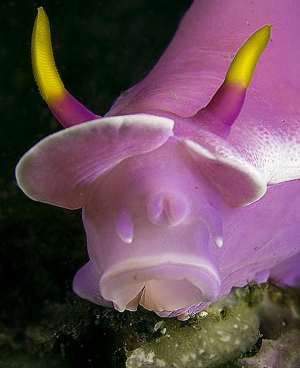
Hi Bill,
Enclosed are a few close-ups of Nudi mouthparts which may be of interest to yourself and others...
Upper right: Hypselodoris apolegma. Lower left: Chromodoris leopardus. Lower right: C. geometrica
Locality: Sulawesi, Indonesia.. Depth: 3 - 20 m. During May 2005. Photographer: Dr Bob Whorton
Bob Whorton
drbob.whorton@btinternet.com
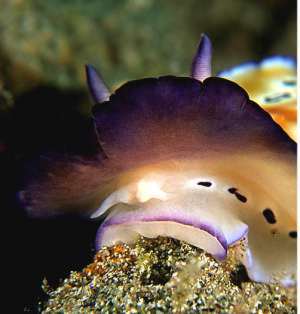

Dear Bob,
Thanks for these, they are a nice addition to the dorid head Fact Sheet. In these photos you can clearly see the snout-like mouth and 'lips' and the pair of oral tentacles. The lower two show the dark purple underside of the anterior mantle, found in only a few, apparently related, species of Chromodoris species.
Best wishes,
Bill Rudman
Chromodoris tinctoria - head waggling behaviour
November 11, 2002
From: Kheong Sann Chan
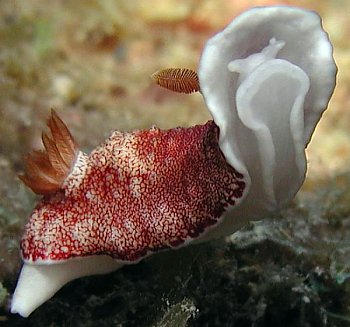
Hi Bill,
On a dive trip to Pulau Dayang, Malaysia, this weekend, we came across a Chromodoris tinctoria. It looked like it was going somewhere and lifted its head as if it was trying to find it's way. Did not notice this behaviour in any nudibranchs before, wondering if you have any explanation for it?
Depth: 13m
Date: 3 Nov 2002
Location: Pulau Dayang, Malaysia
Kheong
kschan@mail.dsi.nus.edu.sg


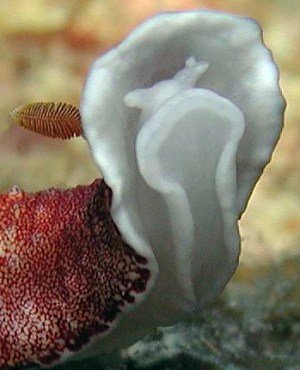
Dear Kheong,
This behaviour is fairly normal for many dorids and other nudibranchs. I have discussed some aspects of this on the Dorid Head Page. Nudibranchs can't see, because their eyes are very poorly developed, so when they are 'looking' for something they have to do it by touch or smell. Although all parts of their body are sensitive to touch, the edge of the mantle, the anterior edge of the foot, and the oral tentacles seem to be constantly 'feeling' the substrate as the animal crawls along. To 'smell' potential food objects, and perhaps potential mates, nudibranchs use their chemosensory organ, the rhinophore. Lifting and waving the anterior end of the body around, as you describe and illustrate in your photo, is the nudibranchs way of 'searching around' for useful stimuli. It can help it find a rock or a sponge which is just above it, and it can help it locate the source of a scent in the water. If its two rhinophores are waved from side to side, even its little brain can balance the unequal stimuli reaching each rhinophore, and so determine the direction in which it is necessary to move to reach the source of the scent or smell.
Best wishes,
Bill Rudman
